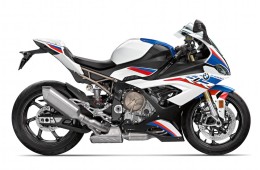Visit the old website: |
Suzuki Hayabusa Stuff:  Tech Specifications Tech Specifications Color Schemes |
Featured story lines: LAMS and Commuter motorcycles Motorcycle Picture Galleries Motorcycle Specs and Pricing |
2018 BMW S1000RR

Welcome to the 2018 BMW S1000RR review and specification page. The BMW S1000RR according the FCAI is the 4th most popular or best selling super sports motorcycle in Australia selling 174 units in 2018. It is a drop on the 209 units sold in 2017 but that could be partly due to an updated 2019 model that was released in late 2018.
BMW as a manufacturer was late to the crotch rocket party in the 80’s 90’s and 2000’s due to corporate reasons. That was not until it was clear that every other car manufacturer also had a motorcycle brand under their control, the longevity and surprising popularity of the GS adventure motorcycle world wide was a beach head to a revived BMW motorcycle range. From the 1990’s the GS and R series spearhead by the updated flat twin engine range in the touring and adventure then finally the tradition defying 4 cylinder sports motorcycle class K and S class where released. It’s a great strategy, the long game and benefitted by often accidental product placement has worked very well accept for a the issue price. BMWs are expensive and often branding is the key reasoning purchasing in the first place rather than whether its is the best model. Put it this way there are more happy Honda owners than BMW owners.
In terms design the BMW S1000RR is not recognisably a BMW and it’s a copy of other brand designs language. My test is simple take all he badges off and see if you can tell which manufacturer it from. That said the only design feature is mis-matched headlights and arguably the key and only BMW motorcycle design feature. (Pity the the 2019 model ditches that theme for a full generic Japanese motorcycle design) I prefer the honestly had far more respect for the R series twins that the S series.
In terms of technology and engines the S1000RR has the latest tech and materials producing class leading power and torque by a few kilowatts. It makes all the difference in the super sports class. Of course it all pretty civil in the low rev range but those who want excitement will have stability control, traction control, Gear shift controls, electronic damper adjustment and the obligitary ECU modes. All to keep the power under control. Of course the max 113 Nm torque figure means that it’s top speed is not quite the claimed 300kph. Also lacking is championship or true winning potential is also missing apart from 1 or 2 wins in the last 20 years. That said Kawasaki wins over the last few years haven’t translated to sales but that for another post. There is also a S1000RR HP4 racing model if the standard version is not enough.
The BMW S1000RR is a Super Sport motorcycle without a pedigree but presumably BMW is planning to change that? Ultimately though while a perfectly good sports motorcycle it is ultimately just like any other in the class but with a higher price tag and also missing the fancy tech like GPS and super charging headliners available to other models in the class to give it a marketing and technology edge.
I think the manufacturers are heading in the direction of designing inherently unstable motorcycles to enable more cornering speed and adjustability like the F-16 fighter, by letting the electronics do the safe keeping! This bring up the point of whether motorcyclists in 2019 are ‘not as good as the last generation’ but are faster than the last generation because of the electronics? I will probably repeat this in every Super Sports motorcycle review I do from now on…
| 2018 BMW S1000RR 1000 Key Specifications | |
| Engine: | IL4 cylinder 4-stroke 16 valve (EFI) |
| Capacity: | 999cc |
| Power/Torque: | 152 Kw @ 13500 RPM 113 Nm @ 11000 RPM |
| Gearbox: | 6 speed |
| Kerb Weight: | 204kg |
| Performance: | 0-100kph N/A seconds Max Speed less than 300Kph |
| Fuel Economy: | 17.5 litre fuel tank Approx. 6.4 litres per 100km |
| Seat height: | 820 mm |
| Dimensions: | L2050mm X 846mm X H1140mm |
| Recommended Retail Price: | $22,390 (2018) |
